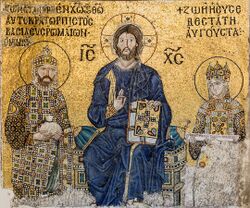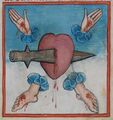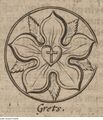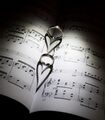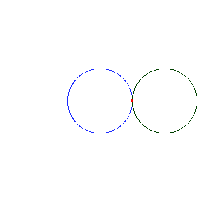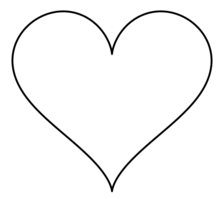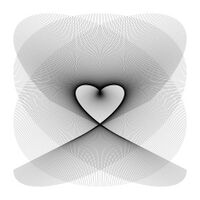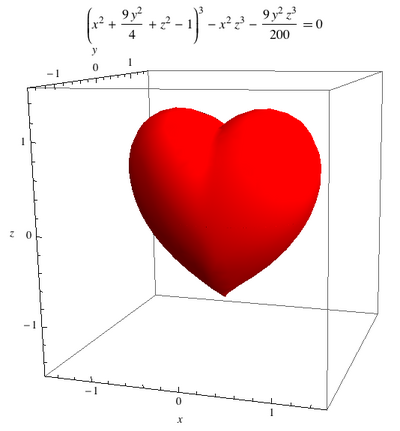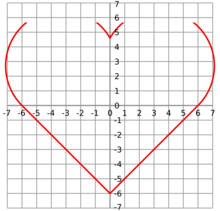Heart (symbol)
The heart shape (♥) is an ideograph used to express the idea of the "heart" in its metaphorical or symbolic sense as the center of emotion, including affection and love, especially romantic love.
The "wounded heart" indicating lovesickness came to be depicted as a heart symbol pierced with an arrow (Cupid's), or heart symbol "broken" in two or more pieces.
History
Origins of symbol
Greek. In the 6th-5th century BC, the heart shape was used to represent the heart-shaped fruit of the plant Silphium,[1] a plant possibly used as a contraceptive[2] Many species in the parsley family have estrogenic properties, and some, such as wild carrot, were used to induce abortion.[3] Silver coins from Cyrene of the 6–5th BC bear a similar design, sometimes accompanied by a silphium plant and is understood to represent its seed or fruit.[4]
Earliest use
The combination of the heart shape and its use within the heart metaphor developed at the end of the Middle Ages, although the shape has been used in many ancient epigraphy monuments and texts. With possible early examples or direct predecessors in the 13th to 14th century, the familiar symbol of the heart represented love developed in the 15th century, and became popular in Europe during the 16th.[5] Before the 14th century, the heart shape was not associated with the meaning of the heart metaphor. The geometric shape itself is found in much earlier sources, but in such instances does not depict a heart, but typically foliage: in examples from antiquity fig leaves, and in medieval iconography and heraldry typically the leaves of ivy and of the water-lily. One possible early use in the 11th century could be found in the manuscript, Al-Maqamat written by Al Hariri of Basra. The manuscript includes an illustration of a farewell greeting between two men while astride their camels, with the heart shape seen prominently over their heads.[6]
The first known depiction of a heart as a symbol of romantic love dates to the 1250s. It occurs in a miniature decorating a capital 'S' in a manuscript of the French Roman de la poire (National Library FR MS. 2086, plate 12). In the miniature a kneeling lover (or more precisely, an allegory of the lover's "sweet gaze" or douz regart) offers his heart to a damsel. The heart here resembles a pine cone (held "upside down", the point facing upward), in accord with medieval anatomical descriptions. However, in this miniature what suggests a heart shape is only the result of a lover's finger superimposed on an object; the full shape outline of the object is partly hidden, and therefore unknown. Moreover, the French title of the manuscript that features the miniature translates into "Novel Of The Pear" in English. Thus the heart shaped object would be a pear; the conclusion that a pear represents a heart is dubious. Opinions therefore differ over this being the first depiction of a heart as symbol of romantic love.[7] Giotto in his 1305 painting in the Scrovegni Chapel (Padua) shows an allegory of charity (caritas) handing her heart to Jesus Christ. This heart is also depicted in the pine cone shape based on anatomical descriptions of the day (still held "upside down"). Giotto's painting exerted considerable influence on later painters, and the motive of Caritas offering a heart is shown by Taddeo Gaddi in Santa Croce, by Andrea Pisano on the bronze door of the south porch of the Baptisterium in Florence (c. 1337), by Ambrogio Lorenzetti in the Palazzo Publico in Siena (c. 1340) and by Andrea da Firenze in Santa Maria Novella in Florence (c. 1365). The convention of showing the heart point upward switches in the late 14th century and becomes rare in the first half of the 15th century.[7]
The "scalloped" shape of the now-familiar heart symbol, with a dent in its base, arises in the early 14th century, at first only lightly dented, as in the miniatures in Francesco Barberino's Documenti d'amore (before 1320). A slightly later example with a more pronounced dent is found in a manuscript from the Cistercian monastery in Brussels (MS 4459–70, fol 192v. Royal Library of Belgium). The convention of showing a dent at the base of the heart thus spread at about the same time as the convention of showing the heart with its point downward.[8] The modern indented red heart has been used on playing cards since the late 15th century.[9]
Various hypotheses attempted to connect the "heart shape" as it evolved in the Late Middle Ages with instances of the geometric shape in antiquity.[10] Such theories are modern, proposed from the 1960s onward, and they remain speculative, as no continuity between the supposed ancient predecessors and the late medieval tradition can be shown. Specific suggestions include: the shape of the seed of the silphium plant, used in ancient times as an herbal contraceptive,[10][11] and stylized depictions of features of the human female body, such as the female's breasts, buttocks, pubic mound, or spread vulva.[12]
Renaissance and early modern
Heart shapes can be seen on the Bible Jesus holds in the Empress Zoë mosaic in the Hagia Sophia in Istanbul, but a reference to the organ was probably not intended. It probably dates from 1239.
Likewise, heart shapes can be seen on various stucco reliefs and wall panels excavated from the ruins of Ctesiphon, the Persian capital (circa 90 BC – 637 AD).[13][14][15]
The Luther rose was the seal that was designed for Martin Luther at the behest of Prince John Frederick, in 1530, while Luther was staying at the Coburg Fortress during the Diet of Augsburg. Luther wrote an explanation of the symbol to Lazarus Spengler: "a black cross in a heart, which retains its natural color, so that I myself would be reminded that faith in the Crucified saves us. 'For one who believes from the heart will be justified' (Romans 10:10)."[16]
The aorta remains visible, as a protrusion at the top centered between the two "chambers" indicated in the symbol, in some depictions of the Sacred Heart well into the 18th century, and is partly still shown today (although mostly obscured by elements such as a crown, flames, rays, or a cross) but the "hearts" suit did not have this element since the 15th century.
The heart symbol reached Japan with the Nanban trade of 1543 to 1614, as evidenced by an Edo period Samurai helmet (dated c. 1630), which includes both the rounded and indented forms of the heart symbol, representing the heart of Marishiten, goddess of archers.[17]
Miniature from the Petit Livre d'Amour (c. 1500), showing the author Pierre Sala depositing his heart in a marguerite flower (symbolizing his mistress, who was called Marguerite). Also worth mentioning is the miniature on fol. 13r, showing two women catching winged hearts in a net.
The Luther rose, 1706 print after the 1530 design.
Augustine of Hippo holding a heart in his hand which is set alight by a ray emanating from divine Truth (Veritas), painting by Philippe de Champaigne, ca. 1650.
Modern
Since the 19th century, the symbol has often been used on Valentine's Day cards, candy boxes, and similar popular culture artifacts as a symbol of romantic love.
The use of the heart symbol as a logograph for the English verb "to love" derives from the use in "I ♥ NY," introduced in 1977.[18]
Heart symbols were used to symbolize "health" or "lives" in video games; influentially so in The Legend of Zelda (1986). Super Mario Bros. 2 (1987, 1988) had a "life bar" composed of hexagons, but in 1990s remakes of these games, the hexagons were replaced by heart shapes. Since the 1990s, the heart symbol has also been used as an ideogram indicating health outside of the video gaming context, e.g. its use by restaurants to indicate heart-healthy nutrient content claim (e.g. "low in cholesterol"). A copyrighted "heart-check" symbol to indicate heart-healthy food was introduced by the American Heart Association in 1995.[19]
Heraldry
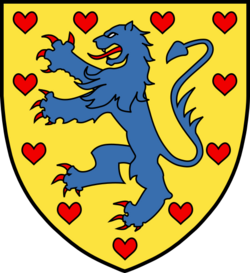
The earliest heart-shaped charges in heraldry appear in the 12th century; the hearts in the coat of arms of Denmark go back to the royal banner of the kings of Denmark, in turn based on a seal used as early as the 1190s. However, while the charges are clearly heart-shaped, they did not in origin depict hearts, or symbolize any idea related to love. Instead they are assumed to have depicted the leaves of the water-lily. Early heraldic heart-shaped charges depicting the leaves of water-lilies are found in various other designs related to territories close to rivers or a coastline (e.g. Flags of Frisia).
Inverted heart symbols have been used in heraldry as stylized testicles (coglioni in Italian) as in the canting arms of the Colleoni family of Milan.[21]
A seal attributed to William, Lord of Douglas (of 1333) shows a heart shape, identified as the heart of Robert the Bruce. The authenticity of this seal is "very questionable",[22] i.e. it could possibly date to the late 14th or even the 15th century.[23]
Heraldic charges actually representing hearts became more common in the early modern period, with the Sacred Heart depicted in ecclesiastical heraldry, and hearts representing love appearing in bourgeois coats of arms. Hearts also later became popular elements in municipal coats of arms.
Botanical symbolism
There has been some conjecture regarding the link between the traditional heart symbol and images of the fruit of Silphium, a (probably) extinct plant known to classical antiquity and belonging to the genus Ferula, used as a condiment and medicine, (the medicinal properties including contraceptive and abortifacient activity, linking the plant to sexuality and love).[24] Silver coins from the ancient Libya of the 6th - 5th BC bear images strongly reminiscent of the heart symbol, sometimes accompanied by images of the Silphium plant.[25][26] The related Ferula species Asafoetida - which was actually used as an inferior substitute for Silphium - is regarded as an aphrodisiac in Tibet and India , suggesting yet a third amatory association relating to Silphium.[27]
Example of a heart-shaped mericarp fruit in a plant (Heracleum sphondylium) belonging, like the unidentified Silphium, to the Parsley family, Apiaceae.
Ferula assa-foetida a species of Giant Fennel belonging to the same genus as the ancient Silphium and regarded as having similar properties, while being an inferior substitute for the plant.
Ferula tingitana : a possible identity for Silphium.
Encoding
A common emoticon for the heart is <3. In Unicode several heart symbols are available:
| Glyph | Description | HTML code | Alt codes |
|---|---|---|---|
| ♡ | U+2661 WHITE HEART SUIT | ♡ or ♡
|
|
| ♥ | U+2665 BLACK HEART SUIT | ♥ or ♥ or ♥
|
Alt + 3 |
| ❤ | U+2764 HEAVY BLACK HEART | ❤ or ❤
|
|
| ❤️️ | U+2764 HEAVY BLACK HEART in emoji representation | ❤️
|
|
| ❥ | U+2765 ROTATED HEAVY BLACK HEART BULLET | ❥ or ❥
|
|
| ❣ | U+2763 HEAVY HEART EXCLAMATION MARK ORNAMENT | ❣ or ❣
|
And from the Miscellaneous Symbols and Pictographs and Supplemental Symbols and Pictographs ranges associated with emoji:
|
|
In Code page 437, the original character set of the IBM PC, the value of 3 (hexadecimal 03) represents the heart symbol. This value is shared with the non-printing ETX control character, which overrides the glyph in many contexts.
The Unicode character of the letter ghan of the Georgian alphabet (ღ) has seen some use as a surrogate heart symbol in online communication.[according to whom?][year needed]
Parametrisation
A number of parametrisations of approximately heart-shaped curves have been described. The best-known of these is the cardioid, which is an epicycloid with one cusp;[28] though as the cardioid lacks the point, it may be seen as a stylized water-lily leaf, a so-called seeblatt, rather than a heart. Other curves, such as the implicit curve (x2+y2−1)3−x2y3=0, may produce better approximations of the heart shape.[29]
[math]\displaystyle{ \textstyle\binom{16\sin^{\scriptscriptstyle 3}t}{13\cos{}t-5\cos2t-2\cos3t-\cos4t} }[/math]
See also
- Cordata, Cordatum and Cordatus, Latin adjectives meaning heart-shaped
- Seeblatt
References
Inline citations
- ↑ Favorito, E. N.; Baty, K. (February 1995). "The Silphium Connection". Celator 9 (2): 6–8.
- ↑ Did the ancient Romans use a natural herb for birth control?, The Straight Dope, October 13, 2006
- ↑ Riddle, John M. (1994). Contraception and Abortion from the Ancient World to the Renaissance. harvard university press. ISBN 978-0674168763.
- ↑ Buttrey, T. V. (Spring–Summer 1992). "The Coins and the Cult". Expedition 34 (1–2): 59–66. http://www.penn.museum/documents/publications/expedition/PDFs/34-1-2/Buttrey.pdf.
- ↑ Kemp (2011), 96–99.
- ↑ "The Pleasure Principles". https://www.topic.com/the-pleasure-principles.
- ↑ 7.0 7.1 Vinken (2001).
- ↑ Vinken (2001): "The change from the spherical to the scalloped form of the heart base happened more or less in train with the differing way in which the heart was held, and has dominated visual representations of the heart ever since."
- ↑ A Brief History of Playing Cardes, by Charles Knutson, Renaissance Magazine 2001 "Archived copy". Archived from the original on 2010-12-20. https://web.archive.org/web/20101220111738/http://renaissancemagazine.com/backissues/game.html. Retrieved 2013-05-27.
- ↑ 10.0 10.1 The Shape of My Heart: Where did the ubiquitous Valentine's symbol come from? by Keelin McDonell, Slate.com, Tuesday, Feb. 13, 2007.
- ↑ Benedictus, Luke (12 February 2006). "Sowing the seeds of love". https://www.theage.com.au/national/sowing-the-seeds-of-love-20060212-ge1qsr.html.
- ↑ proposed by Gloria Steinem in the 1998 introduction to the Vagina Monologues online copy[yes|permanent dead link|dead link}}]; "For example, the shape we call a heart—whose symmetry resembles the vulva far more than the asymmetry of the organ that shares its name—is probably a residual female genital symbol. It was reduced from power to romance by centuries of male dominance.", based on an earlier suggestion by Tanzer (1969) that the shape was used as a symbol indicating brothels in ancient Pompeii. Tanzer (1969). The Common People of Pompeii. A study of the graffiti. With illustrations and a map
- ↑ Roundel with radiating palmettes. (n.d.). Retrieved April 7, 2015, from http://metmuseum.org/exhibitions/view?exhibitionId={60853040-AE7E-4162-8FA7-525505D6B633}&oid=322631
- ↑ Fragments of stucco roundels in situ, Taq-i Kisra, south building, Ctesiphon, Iraq, 1931–32. (n.d.). Retrieved April 7, 2015, from http://www.metmuseum.org/met-around-the-world/images/wb_large/wb_Ctesiphon2.jpg
- ↑ "Wall panel with a guinea fowl [Sasanian] (32.150.13)". In Heilbrunn Timeline of Art History. New York: The Metropolitan Museum of Art, 2000–. http://www.metmuseum.org/toah/works-of-art/32.150.13 (March 2012)
- ↑ gamesmuseum.uwaterloo.ca , i-p-c-s.org "Archived copy". Archived from the original on 2013-09-27. https://web.archive.org/web/20130927130238/http://www.antiquemapsandprints.com/p-11469.jpg. Retrieved 2013-03-17. antiquemapsandprints.com, obviously more research is needed here.[unreliable source?]
- ↑ Samurai helmet representing the flaming jewel, by Unkai Mitsuhisa ca 1630, Ann and Gabriel Barbier-Mueller Collection, exhibited at Boston Fine Arts Museum, April–August 2013.
- ↑ "Subsequently the heart symbol became a shorthand for enthusiasm for everything form software to Yorkshire terriers. It was a stamp that validated lifestyles. People could ♥ their grandchildren or line dancing or Buddha." Stephen Amidon, Thomas Amidon, The Sublime Engine: A Biography of the Human Heart (2011), p. 193.
- ↑ "the heart-check mark that began to appear on a wide array of food packaging in 1995. The symbol consists of a heart branded with a bold, efficient check mark. It is copyrighted by the American Heart Association (AHA) which licences it for a nominal fee to companies whose products meet the organization's criteria for saturated fat and cholesterol content." Stephen Amidon, Thomas Amidon, The Sublime Engine: A Biography of the Human Heart (2011), p. 193.
- ↑ C. Weyers in: Stengel (ed.), Archiv für Diplomatik: Schriftgeschichte, Siegel, und Wappenkunde, Volume 54, 2008, p. 100.
- ↑ Woodward, John and George Burnett (1969). Woodward's a treatise on heraldry, British and foreign, page 203. Originally published 1892, Edinburgh: W. & A. B. Johnson. ISBN:0-7153-4464-1. LCCN 02-20303
- ↑ McAndrew, Scotland's Historic Heraldry, 2006, p. 141
- ↑ McAndrew 2006, p. 213.
- ↑ Favorito, E. N.; Baty, K. (February 1995). "The Silphium Connection". Celator. 9 (2): 6–8.
- ↑ T. V. Buttrey, "The Coins and the Cult", Expedition magazine vol. 34, Nos. 1–2 "Special Issue: Gifts to the Goddesses—Cyrene's Sanctuary of Demeter and Persephone", Spring–Summer 1992.
- ↑ Koerper, H.; Kolls, A. L. (1999). "The silphium motif adorning ancient libyan coinage: Marketing a medicinal plant". Economic Botany 53 (2): 133–143. doi:10.1007/BF02866492.
- ↑ "Aphrodisiac - Asafoetida (Ferula asa foetida)". http://thepoisondiaries.tumblr.com/post/42771270639/aphrodisiac-asafoetida-ferula-asa-foetida.
- ↑ Weisstein, Eric W., "Cardioid" from MathWorld.
- ↑ Eric W. Weisstein, "Heart Curve." From MathWorld
- ↑ "Hamid Naderi Yeganeh, "Heart" (November 2014)". American Mathematical Society. November 2014. http://www.ams.org/mathimagery/displayimage.php?album=40&pid=569#top_display_media. Retrieved March 29, 2015.
Works cited
- Martin Kemp, "The Heart" in Christ to Coke: How Image Becomes Icon, Oxford University Press, 2011, 81–113.
- P. J. Vinken (2000), The Shape of the Heart: A Contribution to the Iconology of the Heart (illustrated ed.), Elsevier Health Sciences, ISBN 978-0-444-82987-0
General references
- Vinken, P (2001), "How the heart was held in medieval art", The Lancet 358 (9299): 2155–2157, doi:10.1016/S0140-6736(01)07224-5, PMID 11784647
External links
- The Heart Symbol – Origin, History And Significance (essay by cardiologist Armin Dietz)
- List of Unicode Heart Symbols


